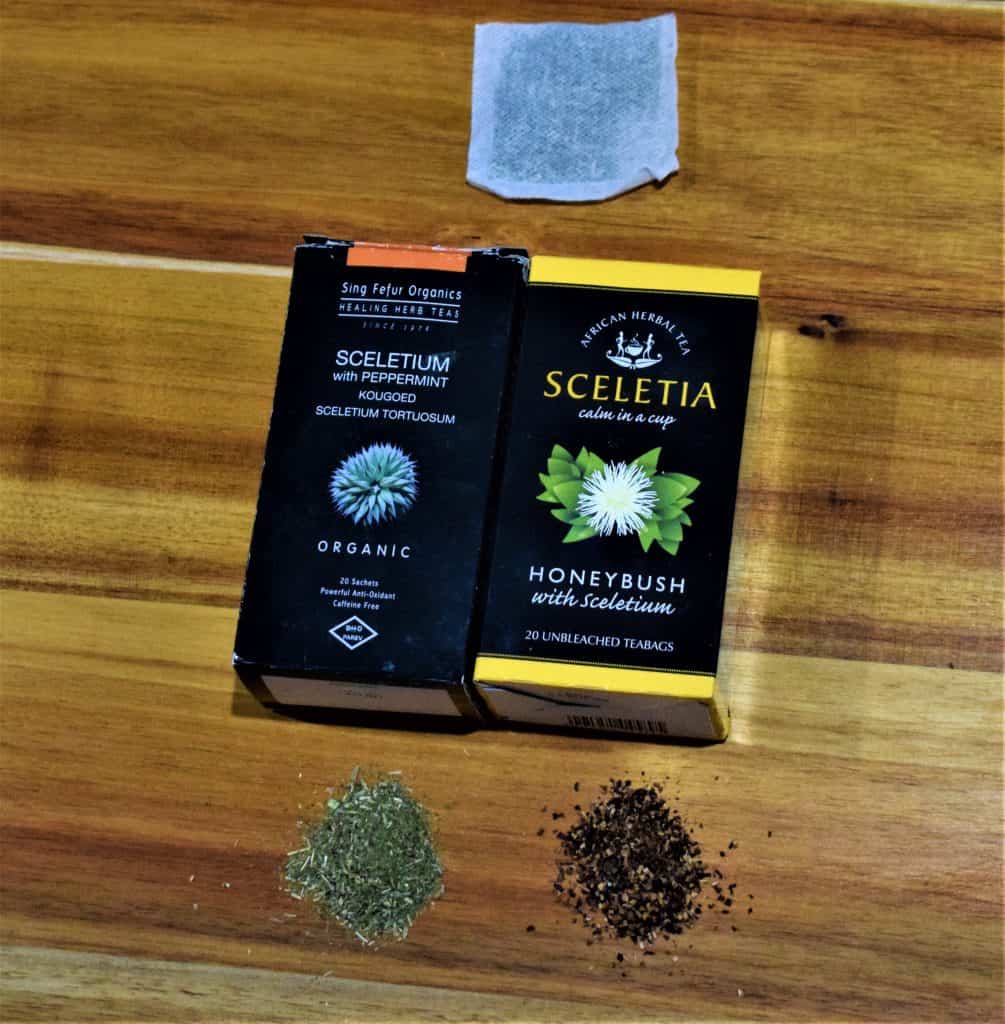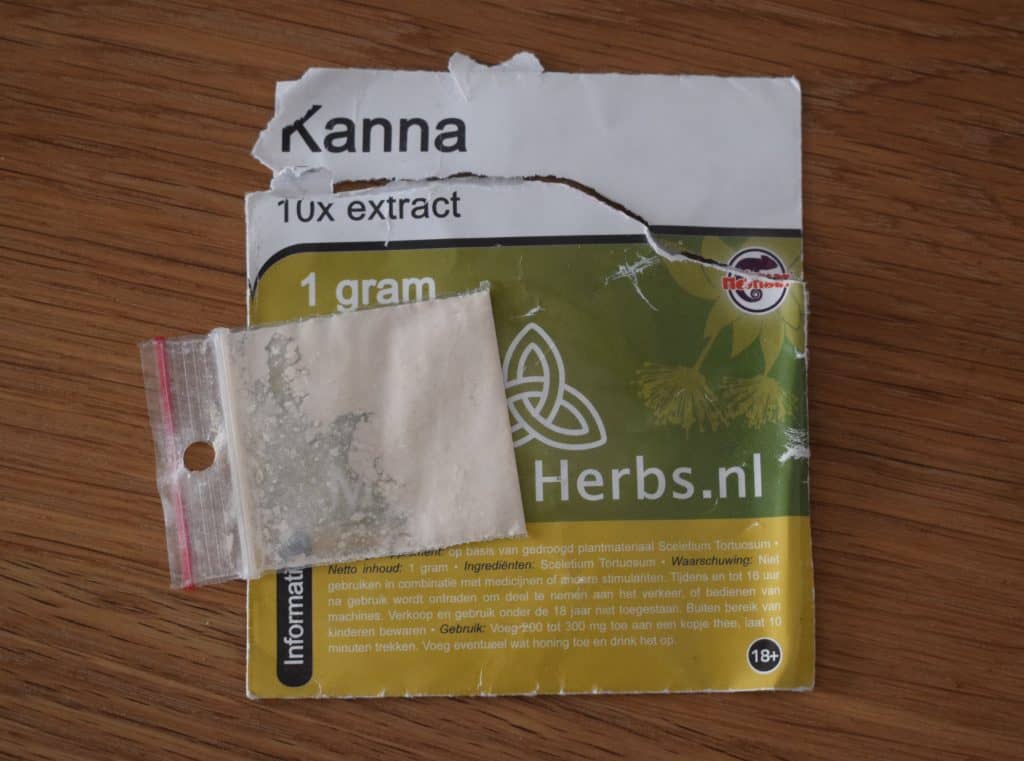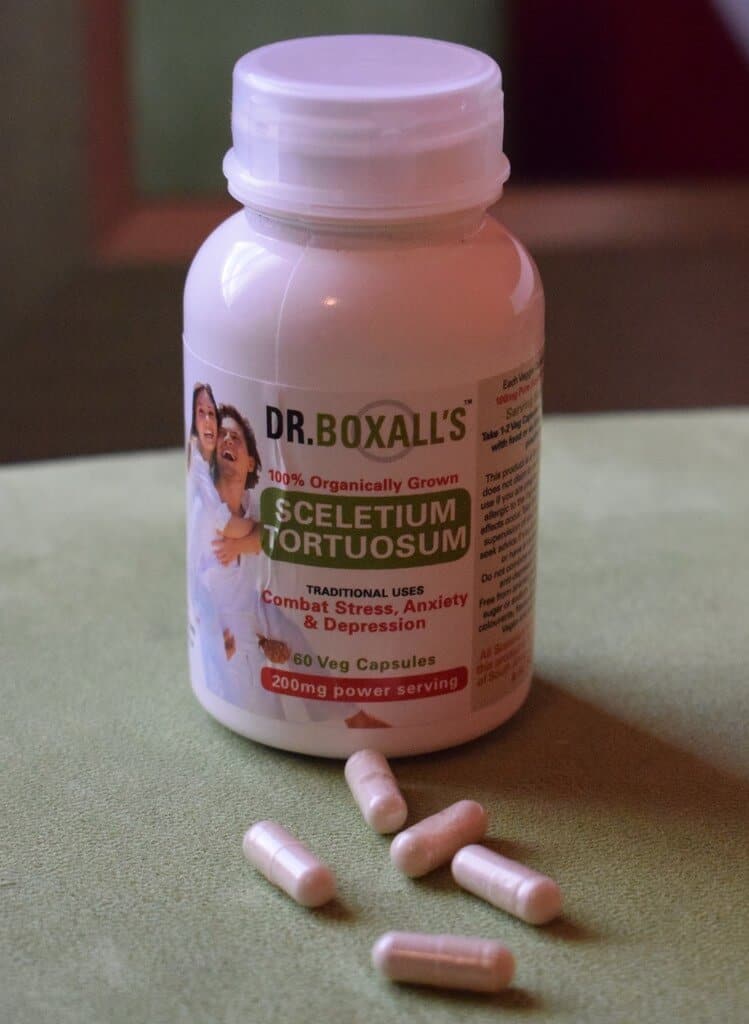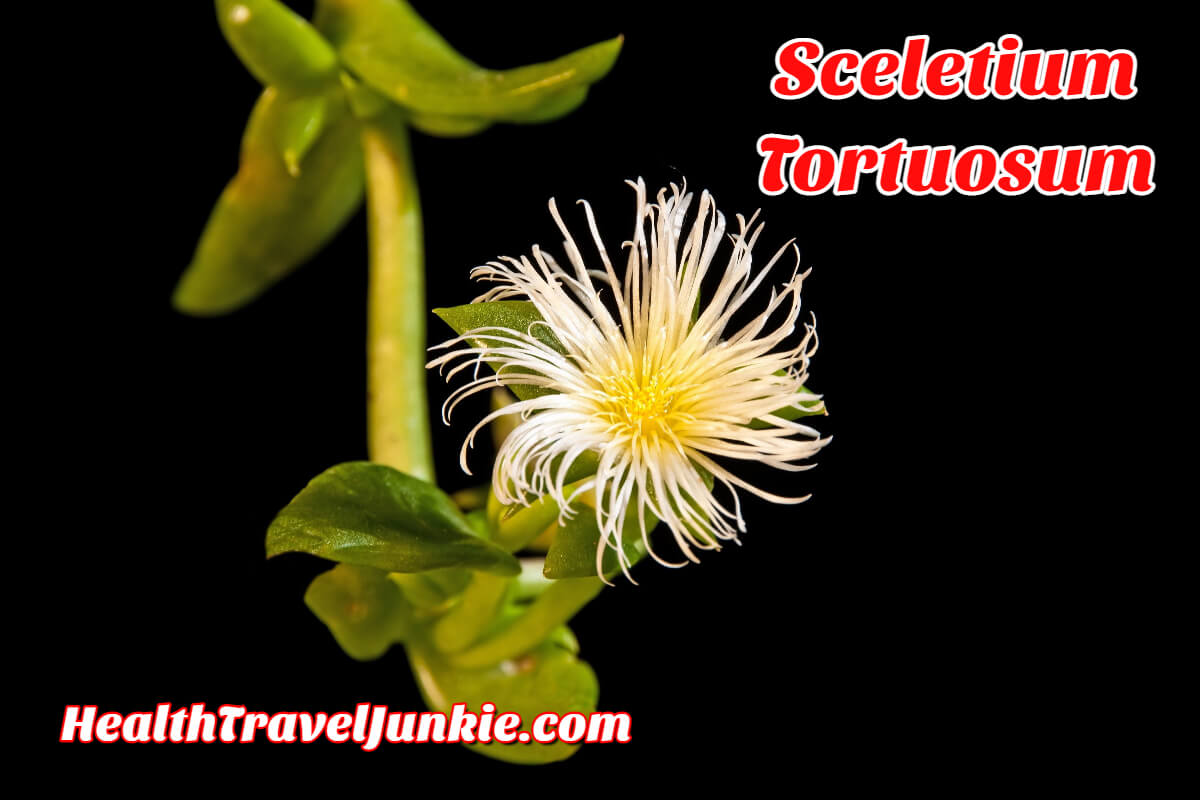Sceletium Tortuosum is one of many herbs available nowadays to help treat anxiety, insomnia, stress, and depression. A growing number of consumers prefer natural alternatives instead of chemical drugs with side-effects. Similar herbs include St John’s Wort, Passionflower, Valerian Root, and Adaptogens like Ginseng or Rhodiola Rosea. These herbs have been around for centuries in folk medicine. In modern society, pharmaceutical companies are increasingly trying to commercialize ancient herbal knowledge.
Contents
What Is Sceletium Tortuosum?
Sceletium Tortuosum is a herb native to South Africa. It is a type of succulent plant that belongs to the Mesembryanthemaceae family. Other names of Sceletium includes Kanna, Channa and Kougoed (rough translation: “something to chew”). During growth in extreme temperatures, its leaves dry out, and become skeleton-ized, to protect the plant. At the same time, the plant’s “inner veins” remain intact. Thus the word “Sceletium” is derived from the Latin: “Sceletus”.
What Is Sceletium Used For?
Traditionally, Sceletium was used by the Khoisan Bushmen for both medical and religious purposes. The leaves were chewed and some of the effects observed were mood enhancement and relaxation. When the European settlers arrived in the Cape of Good Hope (Cape Town, South Africa) they also started experimenting with Sceletium as a herbal remedy.
Eventually, after centuries, Sceletium got acknowledged by medical researchers for its potential in treating anxiety, stress and mild depression. Thus far, benefits observed in scientific studies include: Enhancement in the cognitive function, higher sleep quality and a decrease in anxiety. Sceletium Tortuosum is sometimes also used for weight loss. Plus, some studies show that it has the potential for the treatment of addictions (such as alcoholism or opiates).
How Does It Work?
Studies showed that Sceletium Tortuosum acts in the Central Nervous System (CNS), most precisely in the amygdala. It was identified as a serotonin transporter (5-HT) blocker. Serotonin is a neurotransmitter, which is a chemical that is produced by the brain cells. This chemical is responsible for several body functions, of which mood control is the most well-known. Serotonin helps to reduce depression and regulate anxiety. On the other hand, the serotonin transporter is responsible for terminating the effect of serotonin.
This means that by blocking the serotonin transporter the serotonin will remain effective. And this way, serotonin will keep controlling the mood, regulating anxiety and depression. In fact, most of the medical drugs used to treat both conditions consist of serotonin transporter inhibitors. Thus, in this way, Sceletium Tortuosum can treat anxiety and depression. It can also reduce stress and enhance mood in healthy patients.
The main alkaloid responsible for Sceletium Tortuosum’s natural SSRI (Selective Serotonin Re-uptake Inhibitor) effect is Mesembrine. Minor alkaloids include Mesembrenone and Mesembranol. It is worth noting that there are eight different Sceletium species, and only Sceletium Tortuosum contains all the alkaloids with the herbal benefits. Thus, you could be buying or growing “Sceletium”, but unless it’s Sceletium Tortuosum, it may have very little to zero medicinal benefits.
When Should Sceletium Be Avoided?
As a general rule, women who are pregnant or breastfeeding should avoid Sceletium. Moreover, caution should be used for interaction with prescribed medication. Studies have shown that Sceletium has a high affinity to serotonin transporters. Thus, it may interact with SSRI drugs (such as Prozac or Zoloft). Plus, there is a further possibility of harmful interaction with MAOI plants such as Passionflower, Syrian Rue, and Ayahuasca.
How to take Sceletium Tortuosum?
The traditional way of taking Sceletium is to chew the leaves and swallow the saliva. However, nowadays it is sold in the form of a capsule or tablet. The total recommended daily dose of powdered Kanna supplement (sold in wellness shops) normally range between 50 to 200mg. It’s best to take Sceletium on an empty stomach, to maximize absorption.
Less popular methods of ingestion are
-
Snorting Sceletium powder
-
Brewing a herbal tea
-
Absorbing it from underneath the tongue (sublingual)
-
Smoking the ground up leaves.
-
Tinctures
-
Sceletium Mouth-spray
Sceletium Tortuosum – My Own Experience
The Herbal Capsule
We can assume that the Bushmen in South Africa would not have chewed Sceletium leaves if it didn’t have some kind of mind (or mood) altering effect. Taking a few Sceletium capsules myself, at a low dose, it does seem to have a very mild relaxing effect.
If you take more than one capsule, it can make you feel sleepy. Thus it can be a good choice for insomniacs before bedtime. My own strategy, if I want to get to bed earlier for some reason, would be to take 2 capsules before bedtime. This can be helpful if you have to wake up extra early the next morning. But your body may respond differently to Sceletium than mine.
Another “natural sleeping pill” is Melatonin. But I’ve found this to have nasty side-effects. On the other hand, I’ve yet to encounter any negative side-effects, whatsoever, from pure whole Sceletium capsules.
Kanna Tea
Moreover, I’ve brewed Sceletium tea, but the effect of one cup of tea was almost unnoticeable. Tea is one of the least efficient methods of ingesting Sceletium. Yet, in choosing a herbal tea to drink before bedtime, something like Sceletium or Chamomile will be a much better choice than green or black tea (which contain caffeine).
Usually Kanna tea bags are blended with other herbs such as Honeybush or Peppermint (see photo below). The blend contains 2.5grams of Honeybush per teabag, and only 50miligram of Sceletium. This perhaps explains why the effect is so light. As I mentioned, it’s still a nice calming drink before bedtime, but this could as much be due to the anti-oxidants of the Honeybush, as due the tiny amounts of Sceletium. I’ve yet to encounter a 100% pure Sceletium tea.
As a quite tall male myself, I’d consider brewing two tea bags at once for a double dose of Sceletium, as opposed to only 1 tea bag for e.g. tiny females.

Mouth Spray
I’ve also tested the Sceletium Tortuosum mouth-spray. The effect is similar to the capsule (mildly relaxing). It’s very easy to use – carry it in your backpack and spray into your mouth when needed. Along with the Kanna, the spray contains 43% alcohol as a solvent.

The Alkoloid Extract
Some pharmacies in South Africa sell Sceletium Alkoloid extracts, e.g. “Zembrim”. The negative is that it’s an extract and no longer a whole herb in the form that nature provides. After taking the Zembrim capsule, I experienced unpleasant sensations and thus threw it away. However, I did not experience any negative side-effects with the normal dose of Sceletium powder capsules. As suggested in the Herbalism post, most herbalists recommend taking herbs in a whole form.
10x Kanna Extract
I’ve bought 10x Sceletium (Kanna) extract in the Netherland’s smartshops. I didn’t experience any negative side-effects after swallowing it down with a glass of water. It takes a while to find your ideal dosage when you deal with 10x, 20x or 50x extracts.
Like regular Sceletium, it does help with relaxation and chilling out. Apart from swallowing with water, the potentized extract is often also used for vaping and snorting.
The 10x extract does provide a more intense chill-out effect than a single Sceletium herb capsule. Still, you gotta keep an open mind about potential side-effects down the line, which may be associated with over-use of an extract. It’s an experimental way to deal with stress. One such potential side-effect associated with overuse of extracts could be e.g. anxiety. But otherwise, it’s nice to test out the extract and its effects.

Where To Buy Sceletium Tortuosum?
In its country of origin (South Africa), it’s very easy to find Sceletium capsules, tincture or tea-blends in almost any natural health shop. In other countries, order online (also check the alternative name “Kanna”). As early as 2 or 3 years ago, it wasn’t even possible to find Sceletium on Amazon. But now in 2023, there’s a few good Kanna options available for worldwide shipping. For example, There’s Kannect South African Sceletium or alternatively: Swanson Sceletium.
If you ever visit Amsterdam, you’ll very easily find Sceletium, and potentized Sceletium extracts, in any of the local smartshops dispersed throughout the city.

Can You Grow Kanna Yourself?
Currently, I’m growing my own Sceletium Tortuosum plant indoors. I make sure it gets enough sunlight. I recently started to use specifically cactus or succulent potting soil with my Kanna plants. Regular potting soil can be the wrong moisture and/or nutrient profile for this desert plant. Some may say the type of soil doesn’t matter that much, but my plant is thriving on Cactus potting soil, along with a few more factors mentioned below.
View this post on Instagram
Quoting from the video below, you could grow the plant in your backyard garden from either seeds or cuttings. However, its normal habitat is the desert. Thus over-watering and a cold outdoors climate (especially frost) will kill the plant. Initially, the soil should be somewhat damp. Add a few stones on the top of the soil, underneath the cutting, to protect its leaves from the sand.
2023 Update
I used to have two Kanna plants. Initially, I grew them indoors in small pots. To make sure my Kanna plants get sufficient sunlight, I moved it outdoors. Initially, the leaves and stems started shrivelling up and dying. To reverse the decay of my Sceletium plants, I started watering it daily. I also moved it into a better location outside where it could get even more sun.
Since Kanna is basically a desert plant, cold wind and weather plus too much shade, initially negatively affected my Sceletium Tortuosum. Although it’s been mentioned that over-watering can be detrimental, my Kanna plant is currently doing very well in Cape Town’s hot Summer weather through daily watering and sufficient sun. In the Winter, you should probably water it less.
I ended up planting out both plants to larger pots. As the plants grew it required less water, even in Summer. Once or twice a week was enough. Then, I planted one plant out into an open garden, in the middle of other regular plants. This was a mistake, as Sceletium doesn’t require as much water as the regular plants. Thus, at this stage overwatering killed the plant.
I still have one large flourishing plant in a pot. The pot is like a separate unique desert ecosystem for the kanna plant. Here I can control the watering more efficiently to avoid the overwatering due to water sprinklers in a regular garden setup. So basically you gotta monitor the plants water supply, plus the plants reaction to the water supply, daily. If you do this, you can adjust and keep the plant alive. But once the plant is planted out in the open garden, its much harder to make adjustments.
Kanna Conclusion
Sceletium Tortuosum can help to alleviate the stresses of modern day living. It’s a natural, holistic alternative to chemicals with severe side-effects. In conjunction with a healthy lifestyle and diet, it’s a worthwhile supplement to add to your herbal medicine chest. However, based on existing research, it would probably be an exaggeration to call it a “wonder-herb“. Neither is it ever really “hyped up”… In any case, hopefully there will be more research done in the future on the medicinal applications of Sceletium.
Have you tried Sceletium, and what is your experience? Post your questions or comments below!
Medical Disclaimer: This article isn’t medical advice and is provided for information and entertainment purposes only. If you have any pre-existing conditions, consult your physician before using Sceletium Tortuosum, or quitting prescribed medications.
Sources
Frank, K., Patel, K., Lopez, G. and Willis, B. (2018). Sceletium tortuosum Research Analysis. [online] Available at: https://examine.com/supplements/sceletium-tortuosum/
Harvey, A., Young, L., Viljoen, A. and Gericke, N. (2011). Pharmacological actions of the South African medicinal and functional food plant Sceletium tortuosum and its principal alkaloids. Journal of Ethnopharmacology, 137(3), pp.1124-1129.
Stafford, G., Pedersen, M., van Staden, J. and Jäger, A. (2008). Review on plants with CNS-effects used in traditional South African medicine against mental diseases. Journal of Ethnopharmacology, 119(3), pp.513-537.
Terburg, D., Syal, S., Rosenberger, L., Heany, S., Phillips, N., Gericke, N., Stein, D. and van Honk, J. (2013). Acute Effects of Sceletium tortuosum (Zembrin), a Dual 5-HT Reuptake and PDE4 Inhibitor, in the Human Amygdala and its Connection to the Hypothalamus. Neuropsychopharmacology, 38(13), pp.2708-2716.



Hi daniel great read!I’m looking for some seeds/clones please message me on ydt@hotmail.co.za!
Thanks for the comment.
“Seeds For Africa” usually stock Sceletium seeds. It’s a South African company. They’ll probably ship it to you immediately if you look them up. Here’s the link to their Kanna Seed Product Page.